The Impact of Structural Variations and Coating Techniques on the Microwave Properties of Woven Fabrics Coated with PEDOT:PSS Composition
Abstract
:1. Introduction
2. Materials and Methods
2.1. Materials
Coating of Substrates with Conductive Paste
2.2. Methods
2.2.1. Determination of Structural Parameters
2.2.2. Moisture Management
2.2.3. Aqueous Liquid Repellency Test
2.2.4. SEM Analysis
2.2.5. Evaluation of Electrical Conductivity
2.2.6. Microwave Measurements
3. Results
3.1. Correlation between Electrical Conductivity and Shielding Effectiveness
3.2. Microwave Properties of Coated Fabrics
3.2.1. Electromagnetic Shielding Ability of Coated Fabrics
3.2.2. Influence of Coating Deposit and Textile Substrate Structure on Shielding Properties
3.2.3. Influence of Coating Technology on Microwave Properties
4. Wearing Resistance Performance of PEDOT:PSS-Coated Fabrics
5. Conclusions
Supplementary Materials
Author Contributions
Funding
Institutional Review Board Statement
Data Availability Statement
Conflicts of Interest
References
- The American Cancer Society Medical and Editorial Content Team; Radiofrequency (RF) Radiation. 2022; pp. 1–10. Available online: https://www.cancer.org/cancer/risk-prevention/radiation-exposure/radiofrequency-radiation.html (accessed on 1 September 2023).
- Roh, J.S.; Chi, Y.S.; Kang, T.J.; Nam, S.W. Electromagnetic shielding effectiveness of multifunctional metal composite fabrics. Text. Res. J. 2008, 78, 825–835. [Google Scholar] [CrossRef]
- Bonaldi, R.R.; Siores, E.; Shah, T. Characterization of electromagnetic shielding fabrics obtained from carbon nanotube composite coatings. Synth. Met. 2014, 187, 1–8. [Google Scholar] [CrossRef]
- Hu, M.; Zhang, N.; Shan, G.; Gao, J.; Liu, J.; Li, R.K.Y. Two-dimensional materials: Emerging toolkit for construction of ultrathin high-efficiency microwave shield and absorber. Front. Phys. 2018, 13, 138113. [Google Scholar] [CrossRef]
- Yin, J.; Ma, W.; Gao, Z.; Lei, X.; Jia, C. A review of electromagnetic shielding fabric, wave-absorbing fabric and wave-transparent fabric. Polymers 2022, 14, 377. [Google Scholar] [CrossRef]
- Lai, H.; Levitt, B.B. The roles of intensity, exposure duration, and modulation on the biological effects of radiofrequency radiation and exposure guidelines. Electromagn. Biol. Med. 2022, 41, 230–255. [Google Scholar] [CrossRef]
- International Agency for Research on Cancer (IARC). Radiation, Part 2: Non-Ionizing Radiofrequency Electromagnetic Fields, Monographs on the Evaluation of Carcinogenic Risks to Human; IARC: Lyon, France, 2013; Volume 102. [Google Scholar]
- Miller, A.B.; Morgan, L.L.; Udasin, I.; Davis, D.L. Cancer epidemiology update, following the 2011 IARC evaluation of radiofrequency electromagnetic fields (Monograph 102). Environ. Res. 2018, 167, 673–683. [Google Scholar] [CrossRef] [PubMed]
- Kruželak, J.; Kvasničakova, A.; Hložekova, K.; Hudec, I. Progress in polymers and polymer composites used as efficient materials for EMI shielding. Nanosc. Adv. 2021, 3, 123–172. [Google Scholar] [CrossRef]
- Brzezinski, S.; Rybicki, T.; Karbownik, I.; Malinowska, G. Light, multi-layer, screening textiles with a high capacity for absorbing electromagnetic fields in the high frequency range. Int. J. Mat. Res. 2012, 103, 638–642. [Google Scholar] [CrossRef]
- Maity, S.; Singha, K.; Debnath, P.; Singha, M. Textiles in electromagnetic radiation protection. J. Saf. Eng. 2013, 2, 11–19. [Google Scholar]
- Saini, P.; Arora, M. Microwave absorption and EMI shielding behavior of nanocomposites based on intrinsically conducting polymers, graphene and carbon nanotubes. New Polym. Spec. Appl. 2012, 3, 73–112. [Google Scholar]
- Brzezinski, S.; Rybicki, T.; Karbownik, I.; Malinowska, G.; Sledzinska, K. Textile materials for electromagnetic field shielding made with the use of nano-and micro-technology. Cent. Eur. J. Phys. 2012, 10, 1190–1196. [Google Scholar] [CrossRef]
- Blachowicz, T.; Wojcik, D.; Surma, M.; Magnuski, M.; Ehrmann, G.; Ehrmann, A. Textile Fabrics as Electromagnetic Shielding Materials—A Review of Preparation and Performance. Fibers 2023, 11, 29. [Google Scholar] [CrossRef]
- Dai, M.; Zhai, Y.; Zhang, Y. A green approach to preparing hydrophobic, electrically conductive textiles based on waterborne polyurethane for electromagnetic interference shielding with low reflectivity. Chem. Eng. J. 2021, 421, 127749. [Google Scholar] [CrossRef]
- Kim, C.; Kim, M. Intrinsically conducting polymer (ICP) coated aramid fiber reinforced composites for broadband radar absorbing structures (RAS). Compos. Sci. Technol. 2021, 211, 108827. [Google Scholar] [CrossRef]
- Palanisamy, S.; Tunakova, V.; Militky, J. Fiber-based structures for electromagnetic shielding–comparison of different materials and textile structures. Text. Res. J. 2018, 88, 1992–2012. [Google Scholar] [CrossRef]
- Apreutesei, A.-L.; Curteza, A.; David, V.; Nica, I.; Rau, M.; Baltag, O. Investigation of the textile structures with different design used in electromagnetic shielding. In Proceedings of the 2014 International Conference and Exposition on Electrical and Power Engineering (EPE), Iasi, Romania, 16–18 October 2014; IEEE: New York, NY, USA, 2014; pp. 596–601. [Google Scholar]
- Tseghai, G.B.; Mengistie, D.A.; Malengier, B.; Fante, K.A.; Van Langenhove, L. PEDOT: PSS-based conductive textiles and their applications. Sensors 2020, 20, 1881. [Google Scholar] [CrossRef] [PubMed]
- Safarova, V.; Militky, J. Electromagnetic field shielding fabrics with increased comfort properties. Adv. Mater. Res. 2013, 677, 161–168. [Google Scholar] [CrossRef]
- Wang, L.; Cheng, J.; Zou, Y.; Zheng, W.; Wang, Y.; Liu, Y.; Zhang, H.; Zhang, D.; Ji, X. Current advances and future perspectives of MXene-based electromagnetic interference shielding materials. Adv. Compos. Hybrid Mater. 2023, 6, 172. [Google Scholar] [CrossRef]
- Wang, X.; Lei, Z.; Ma, X.; He, G.; Xu, T.; Tan, J.; Wang, L.; Zhang, X.; Qu, L.; Zhang, X. A lightweight MXene-coated nonwoven fabric with excellent flame retardancy, EMI shielding, and electrothermal/photothermal conversion for wearable heater. Chem. Eng. J. 2022, 430, 132605. [Google Scholar] [CrossRef]
- Zheng, X.; Wang, P.; Zhang, X.; Hu, Q.; Wang, Z.; Nie, W.; Zou, L.; Li, C.; Han, X. Breathable, durable and bark-shaped MXene/textiles for high-performance wearable pressure sensors, EMI shielding and heat physiotherapy. Compos. Part A 2022, 152, 106700. [Google Scholar] [CrossRef]
- Nair, A.M.; Zachariah, S.M.; Thomas, S. A Mini-Review On MXene Based Textiles For Electromagnetic Interference Shielding Application. Qeios 2022, 6WR0R5, 1–21. [Google Scholar]
- Liang, C.; Zhang, W.; Liu, C.; He, J.; Xiang, Y.; Han, M.; Tong, Z.; Liu, Y. Multifunctional phase change textiles with electromagnetic interference shielding and multiple thermal response characteristics. Chem. Eng. J. 2023, 471, 144500. [Google Scholar] [CrossRef]
- Onggar, T.; Kruppke, I.; Cherif, C. Techniques and processes for the realization of electrically conducting textile materials from intrinsically conducting polymers and their application potential. Polymers 2020, 12, 2867. [Google Scholar] [CrossRef] [PubMed]
- Hebeish, A.A.; Elgamel, M.A.; Abdelhady, R.A.; Abdelaziz, A.A. Factors affecting the performance of the radar absorbant textile materials of different types and structures. Prog. Electromagn. Res. B 2008, 3, 219–226. [Google Scholar] [CrossRef]
- Zhang, L.; Fairbanks, M.; Andrew, T.L. Rugged textile electrodes for wearable devices obtained by vapor coating off-the-shelf, plain-woven fabrics. Adv. Funct. Mater. 2017, 27, 1700415. [Google Scholar] [CrossRef]
- Akram, S.; Ashraf, M.; Javid, A.; Abid, H.A.; Ahmad, S.; Nawab, Y.; Rasheed, A.; Xue, Z.; Nosheen, A. Recent advances in electromagnetic interference (EMI) shielding textiles: A comprehensive review. Synth. Met. 2023, 294, 117305. [Google Scholar] [CrossRef]
- Ghosh, S.; Ganguly, S.; Remanan, S.; Das, N.C. Fabrication and investigation of 3D tuned PEG/PEDOT: PSS treated conductive and durable cotton fabric for superior electrical conductivity and flexible electromagnetic interference shielding. Compos. Sci. Technol. 2019, 181, 107682. [Google Scholar] [CrossRef]
- Tadesse, M.G.; Mengistie, D.A.; Chen, Y.; Wang, L.; Loghin, C.; Nierstrasz, V. Electrically conductive highly elastic polyamide/lycra fabric treated with PEDOT: PSS and polyurethane. J. Mater. Sci. 2019, 54, 9591–9602. [Google Scholar] [CrossRef]
- Alamer, F.A. A simple method for fabricating highly electrically conductive cotton fabric without metals or nanoparticles, using PEDOT: PSS. J. Alloys Compd. 2017, 702, 266–273. [Google Scholar] [CrossRef]
- Alamer, A.F.; Althagafy, K.; Alsalmi, O.; Aldeih, A.; Alotaiby, H.; Althebaiti, M.; Alghamdi, H.; Alotibi, N.; Saeedi, A.; Zabarmaxi, Y.; et al. Review on PEDOT: PSS-Based Conductive Fabric. ACS Omega 2022, 7, 35371–35386. [Google Scholar] [CrossRef]
- Ding, Y.; Invernale, M.A.; Sotzing, G.A. Conductivity Trends of PEDOT-PSS Impregnated Fabric and the Effect of Conductivity on Electrochromic Textile. ACS Appl. Mater. Interfaces 2010, 2, 1588–1593. [Google Scholar] [CrossRef]
- Åkerfeldt, M.; Strååt, M.; Walkenström, P. Electrically conductive textile coating with a PEDOT-PSS dispersion and a polyurethane binder. Text. Res. J. 2013, 83, 618–627. [Google Scholar] [CrossRef]
- CEN/TR 16298:2011; Textiles and Textile Products—Smart Textiles—Definitions, Categorization, Applications and Standardization Needs. European Standardization Organizations: Brussels, Belgium, 2011.
- Zahid, M.; Papadopoulou, E.L.; Athanassiou, A.; Bayer, I.S. Strain-responsive mercerized conductive cotton fabrics based on PEDOT: PSS/graphene. Mater. Des. 2017, 135, 213–222. [Google Scholar] [CrossRef]
- Tseghai, G.B.; Malengier, B.; Fante, K.A.; Nigusse, A.B.; Van Langenhove, L. Development of a flex and stretchy conductive cotton fabric via flat screen printing of PEDOT: PSS/PDMS conductive polymer composite. Sensors 2020, 20, 1742. [Google Scholar] [CrossRef] [PubMed]
- Shin, S.; Lee, E.; Cho, G. Nylon 6 nanofiber web-Based signal transmission line treated with PEDOT: PSS and DMSO treatment. Materials 2021, 14, 498. [Google Scholar] [CrossRef]
- Kim, M.L.; Otal, E.H.; Sinatra, N.R.; Dobson, K.; Kimura, M. Washable PEDOT: PSS Coated Polyester with Submicron Sized Fibers for Wearable Technologies. ACS Omega 2023, 8, 3971–3980. [Google Scholar] [CrossRef]
- Yeon, C.; Kim, G.; Lim, J.W.; Yun, S.J. Highly conductive PEDOT: PSS treated by sodium dodecyl sulfate for stretchable fabric heaters. RSC Adv. 2017, 7, 5888–5897. [Google Scholar] [CrossRef]
- Moraes, M.R.; Alves, A.C.; Toptan, F.; Martins, M.S.; Vieira, E.M.; Paleo, A.J.; Souto, A.P.; dos Santos, W.L.F.; Esteves, M.F.; Zille, A. Glycerol/PEDOT: PSS coated woven fabric as a flexible heating element on textiles. J. Mater. Chem. C 2017, 5, 3807–3822. [Google Scholar] [CrossRef]
- Islam, M.Z.; Deb, H.; Hasan, M.K.; Khoso, N.A.; Hossain, M.K.; Wentong, Y.; Qi, X.; Dong, Y.; Zhu, Y.; Fu, Y. A facile one-pot scalable production of super electromagnetic shielding conductive cotton fabric by hierarchical graphene-composites. J. Mater. Sci. 2022, 57, 15451–15463. [Google Scholar] [CrossRef]
- Sharma, G.K.; James, N.R. Highly flexible, PEDOT: PSS-polyvinylpyrrolidone coated carbon nanofiber-polydimethylsiloxane composite for electromagnetic interference shielding. Synth. Met. 2023, 296, 117376. [Google Scholar] [CrossRef]
- Bora, P.J.; Anil, A.G.; Vinoy, K.J.; Ramamurthy, P.C. Outstanding absolute electromagnetic interference shielding effectiveness of cross-linked PEDOT: PSS film. Adv. Mater. Interfaces 2019, 6, 1901353. [Google Scholar] [CrossRef]
- Rubežienė, V.; Baltušnikaite-Guzaitienė, J.; Abraiteinė, A.; Sankauskaitė, A.; Ragulis, P.; Santos, G.; Pimenta, J. Development and investigation of PEDOT: PSS composition coated fabrics intended for microwave shielding and absorption. Polymers 2021, 13, 1191. [Google Scholar] [CrossRef] [PubMed]
- Savitha, K.U.; Kavitha, A.L.; Revathi, M. An overview of electrically conducting textiles. J. Adv. Sci. Res. 2023, 14, 1–14. [Google Scholar]
- EN 12127:1997; Textiles–Fabrics–Determination of Mass Per Unit Area Using Small Samples. European Standardization Organizations: Brussels, Belgium, 1997.
- EN 1049-2:1993; Textiles—Woven Fabrics—Construction—Methods of Analysis—Part 2: Determination of Number of Threads Per Unit Length. European Standardization Organizations: Brussels, Belgium, 1993.
- ISO 5084:1996; Textiles—Determination of Thickness of Textiles and Textile Products. ISO: Geneva, Switzerland, 1996.
- ISO 9237: 1995; Textiles—Determination of the Permeability of Fabrics to Air. ISO: Geneva, Switzerland, 1995.
- ISO 139: 2005; Textiles—Standard Atmospheres for Conditioning and Testing. ISO: Geneva, Switzerland, 2005.
- AATCC TM195-TM 195; Liquid Moisture Management Properties of Textile Fabrics. American Association of Textile Chemists and Colorists: Research Triangle Park, NC, USA, 2022.
- ISO 23232:2009; Textiles—Aqueous Liquid Repellency—Water/Alcohol Solution Resistance Test. ISO: Geneva, Switzerland, 2009.
- EN 16812: 2016; Textiles and Textile Products—Electrically Conductive Textiles—Determination of the Linear Electrical Resistance of Conductive Tracks. European Standardization Organizations: Brussels, Belgium, 2016.
- EN 1149-1:2006; Protective Clothing—Electrostatic Properties—Part 1: Test Method for Measurement of Surface Resistivity. European Standardization Organizations: Brussels, Belgium, 2006.
- EN 1149-2:1997; Protective clothing—Electrostatic properties—Part 2: Test Method for Measurement of the Electrical Resistance through a Material (Vertical Resistance). European Standardization Organizations: Brussels, Belgium, 1997.
- Šafarova, V.; Tunak, M.; Militky, J. Prediction of hybrid woven fabric electromagnetic shielding effectiveness. Text. Res. J. 2015, 85, 673–686. [Google Scholar] [CrossRef]
- Gupta, K.; Abbas, S.; Abhyankar, A. Carbon black/polyurethane nanocomposite-coated fabric for microwave attenuation in X & Ku-band (8–18 GHz) frequency range. J. Ind. Text. 2016, 46, 510–529. [Google Scholar]
- King, J.A.; Pisani, W.A.; Klimek-McDonald, D.R.; Perger, W.F.; Odegard, G.M.; Turpeinen, D.G. Shielding effectiveness of carbon-filled polypropylene composites. J. Compos. Mater. 2016, 50, 2177–2189. [Google Scholar] [CrossRef]
- Mahanta, U.J.; Borah, M.; Bhattacharyya, N.S.; Gogoi, J.P. High-performance broadband microwave absorbers using multilayer dual-phase dielectric composites. J. Electron. Mater. 2019, 48, 2438–2448. [Google Scholar] [CrossRef]
- Redlich, G.; Obersztyn, E.; Olejnik, M.; Fortuniak, K.; Bartczak, A.; Szugajew, L.; Jarzemski, J. New textiles designed for anti-radar camouflage. Fibres Text. East. Eur. 2014, 22, 34–42. [Google Scholar]
- Committee for Conformity Assessment on Accreditation and Certification of Functional and Technical Textiles. Specified Re-Quirements of Electromagnetic Shielding Textiles. 2010. Available online: http://www.ftts.org.tw/images/fa003E.pdf (accessed on 12 May 2023).
- Gupta, K.K.; Abbas, S.M.; Abhyankar, A.C. Effect of yarn composition and fabric weave design on microwave and EMI shielding properties of hybrid woven fabrics. J. Text. Inst. 2022, 113, 1862–1877. [Google Scholar] [CrossRef]
- Lund, A.; van der Velden, N.M.; Persson, N.K.; Hamedi, M.M.; Müller, C. Electrically conducting fibres for e-textiles: An open playground for conjugated polymers and carbon nanomaterials. Mater. Sci. Eng. R Rep. 2018, 126, 1–29. [Google Scholar] [CrossRef]
- Pupeikė, J.; Sankauskaitė, A.; Varnaitė-Žuravliova, S.; Rubežienė, V.; Abraitienė, A. Investigation of Electrical and Wearing Properties of Wool Fabric Coated with PEDOT:PSS. Polymers 2023, 15, 2539. [Google Scholar] [CrossRef] [PubMed]
- Deogaonkar, S.C. Dielectric barrier discharge plasma induced surface modification of polyester/cotton blend fabrics to improve polypyrrole coating adhesion and conductivity. J. Text. Inst. 2020, 111, 1530–1537. [Google Scholar] [CrossRef]
- Abraitienė, A.; Sankauskaitė, A.; Rubežienė, V. Manufacture of Electro-Magnetic Shielding Textiles with Conductive Organic Polymeric Coating. European Patent Application No. 20179467.4-1107, 17 August 2020. [Google Scholar]
 —weft direction;
—weft direction;  —warp direction): (a) PC, (b) NV, (c) C, (d) P, and (e) AV.
—warp direction): (a) PC, (b) NV, (c) C, (d) P, and (e) AV.
 —weft direction;
—weft direction;  —warp direction): (a) PC, (b) NV, (c) C, (d) P, and (e) AV.
—warp direction): (a) PC, (b) NV, (c) C, (d) P, and (e) AV.
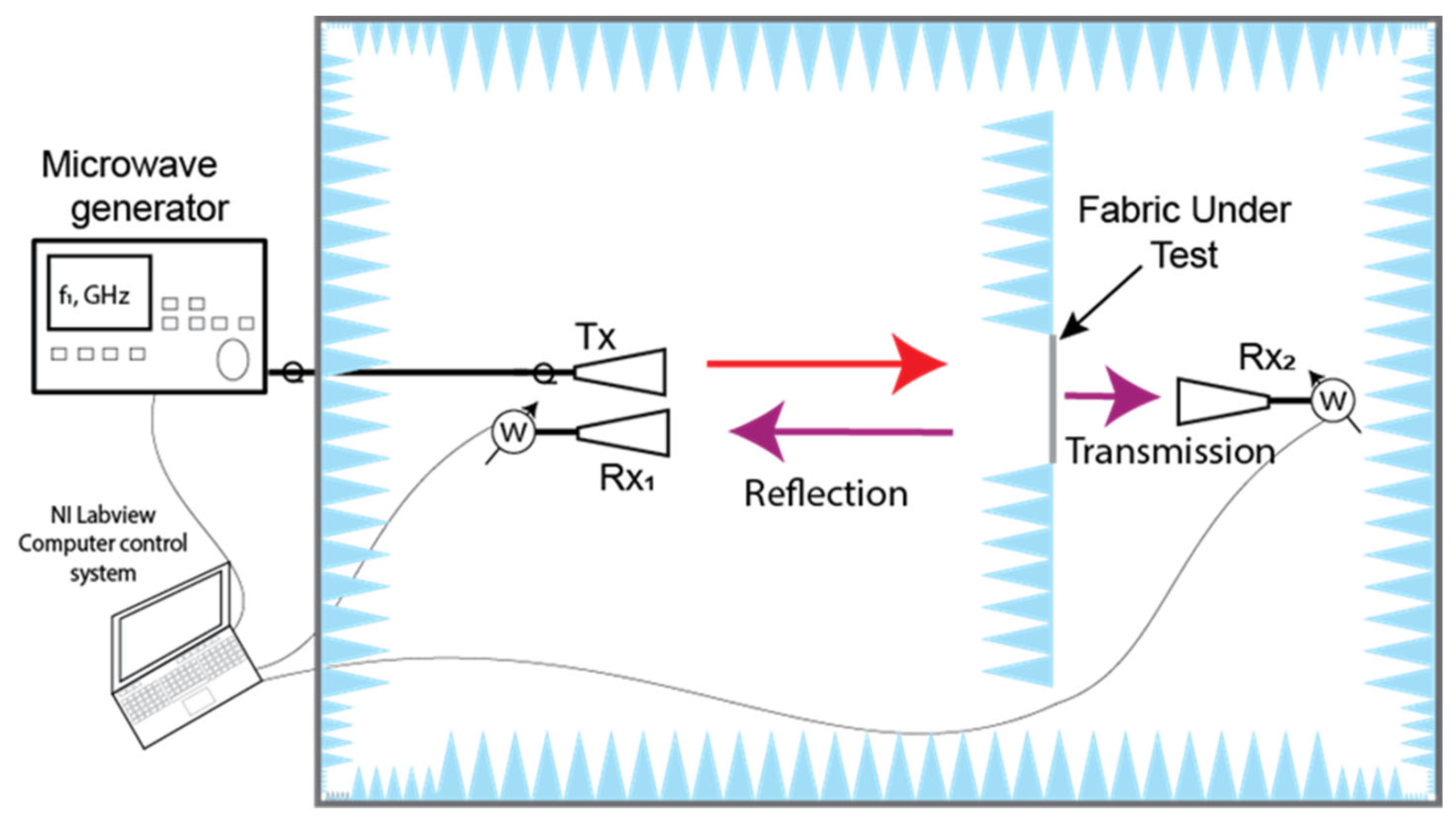
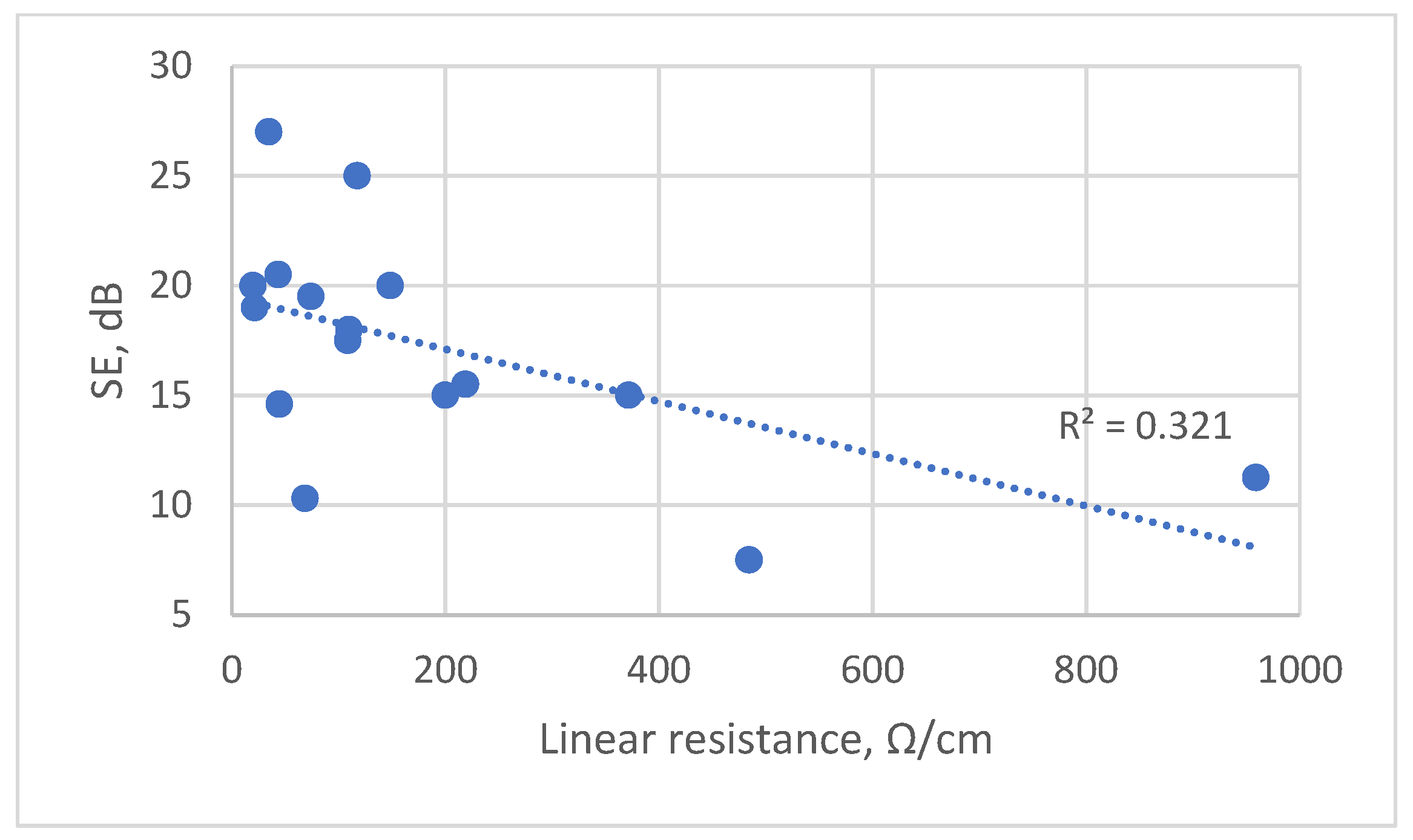
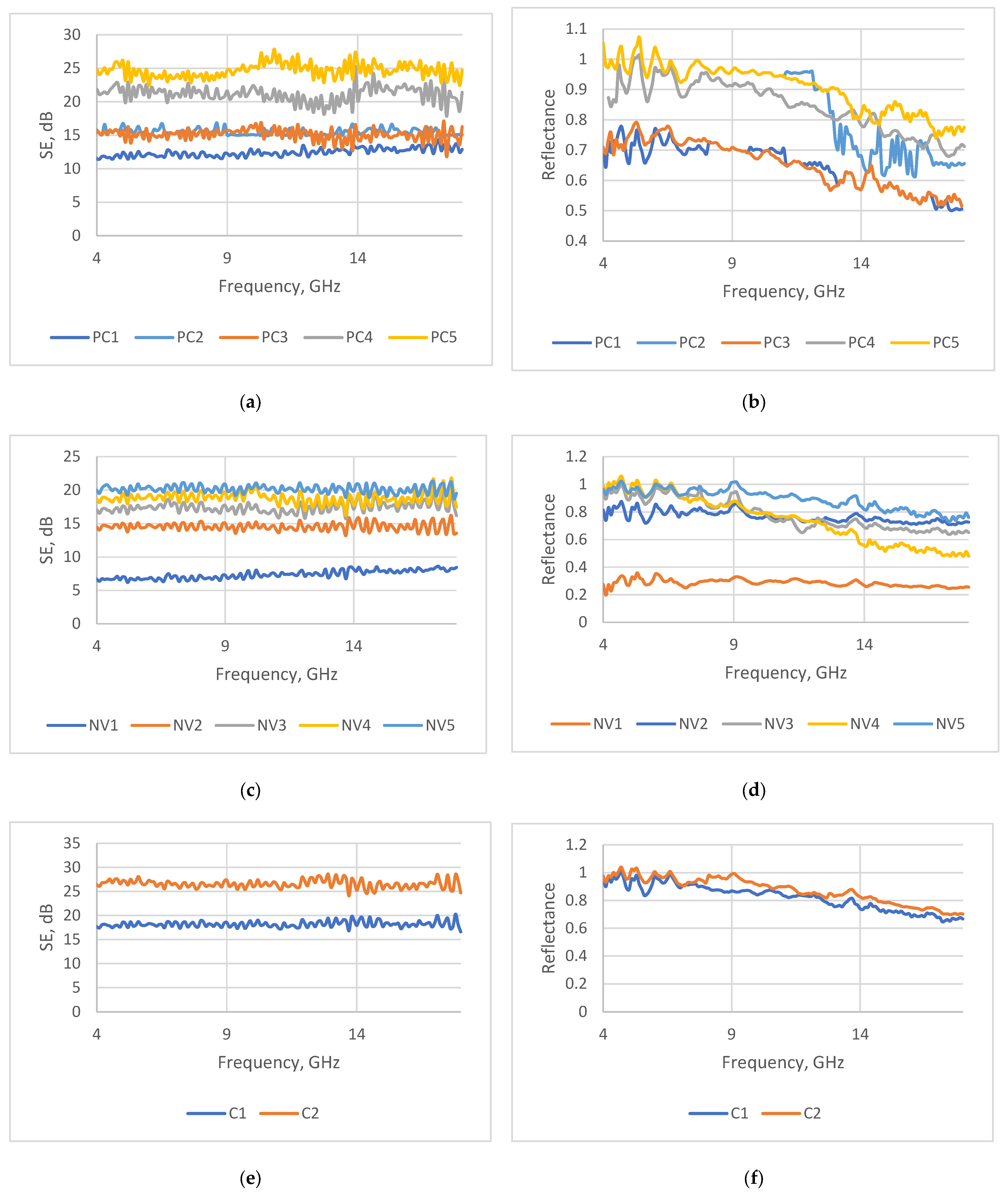
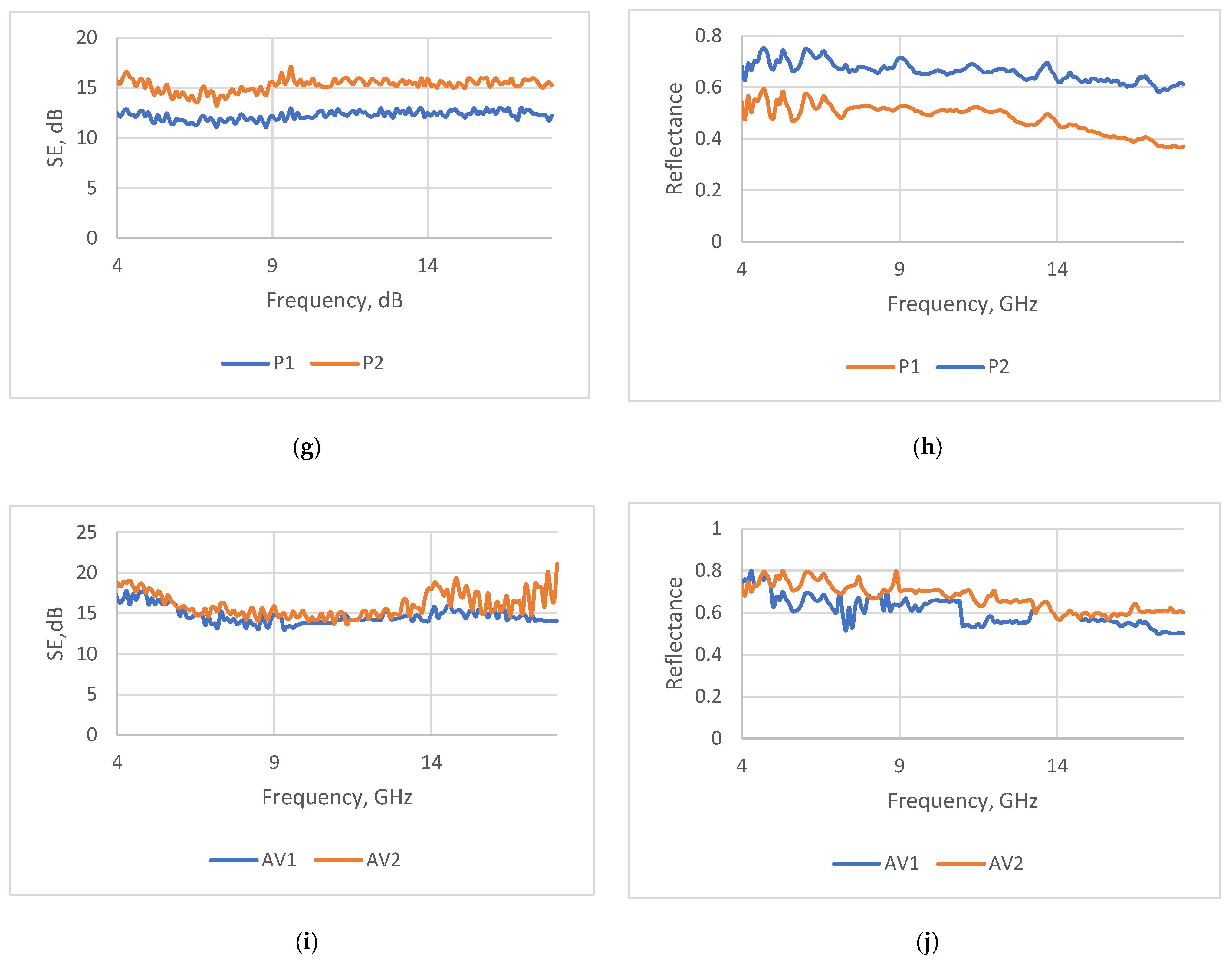
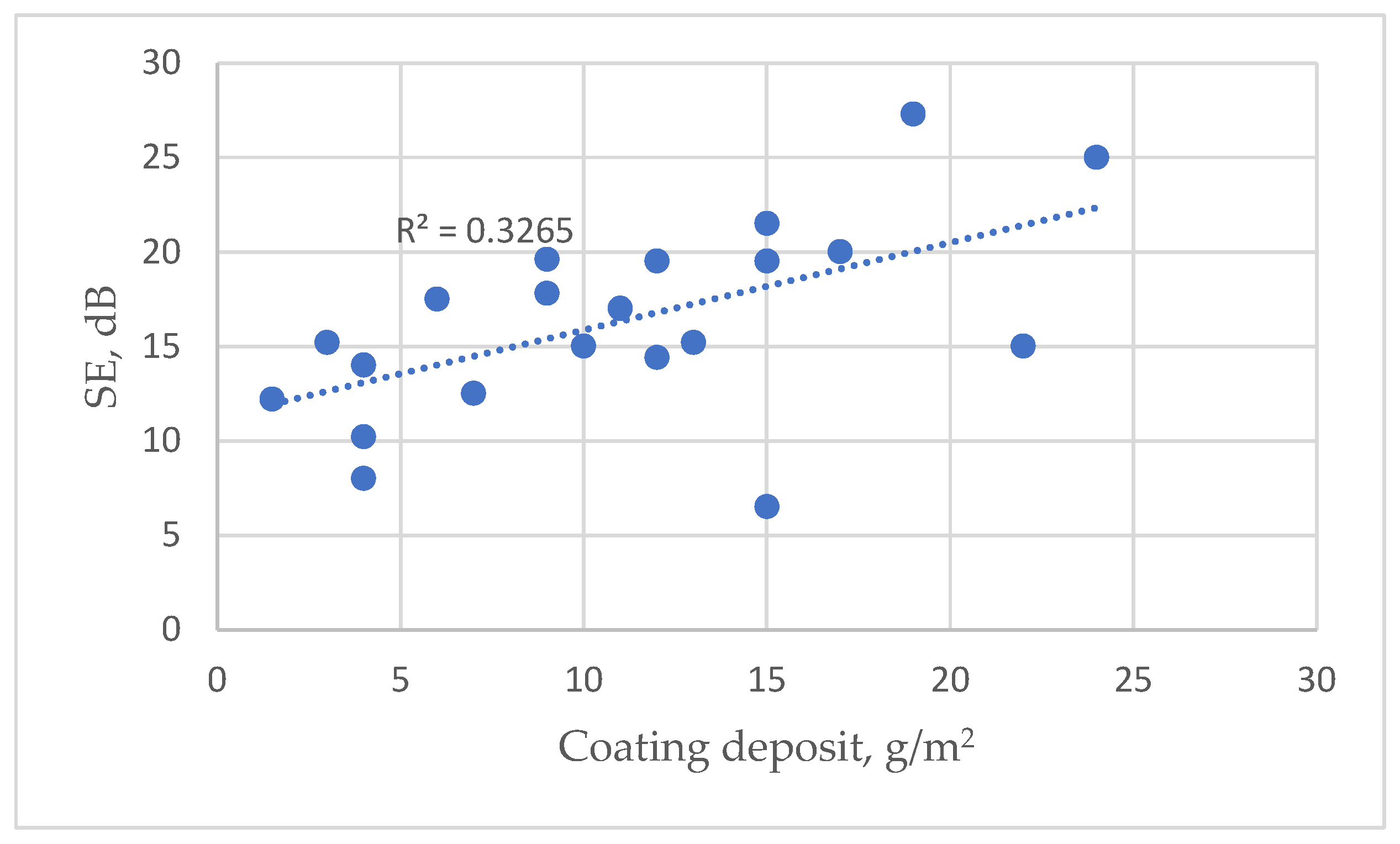


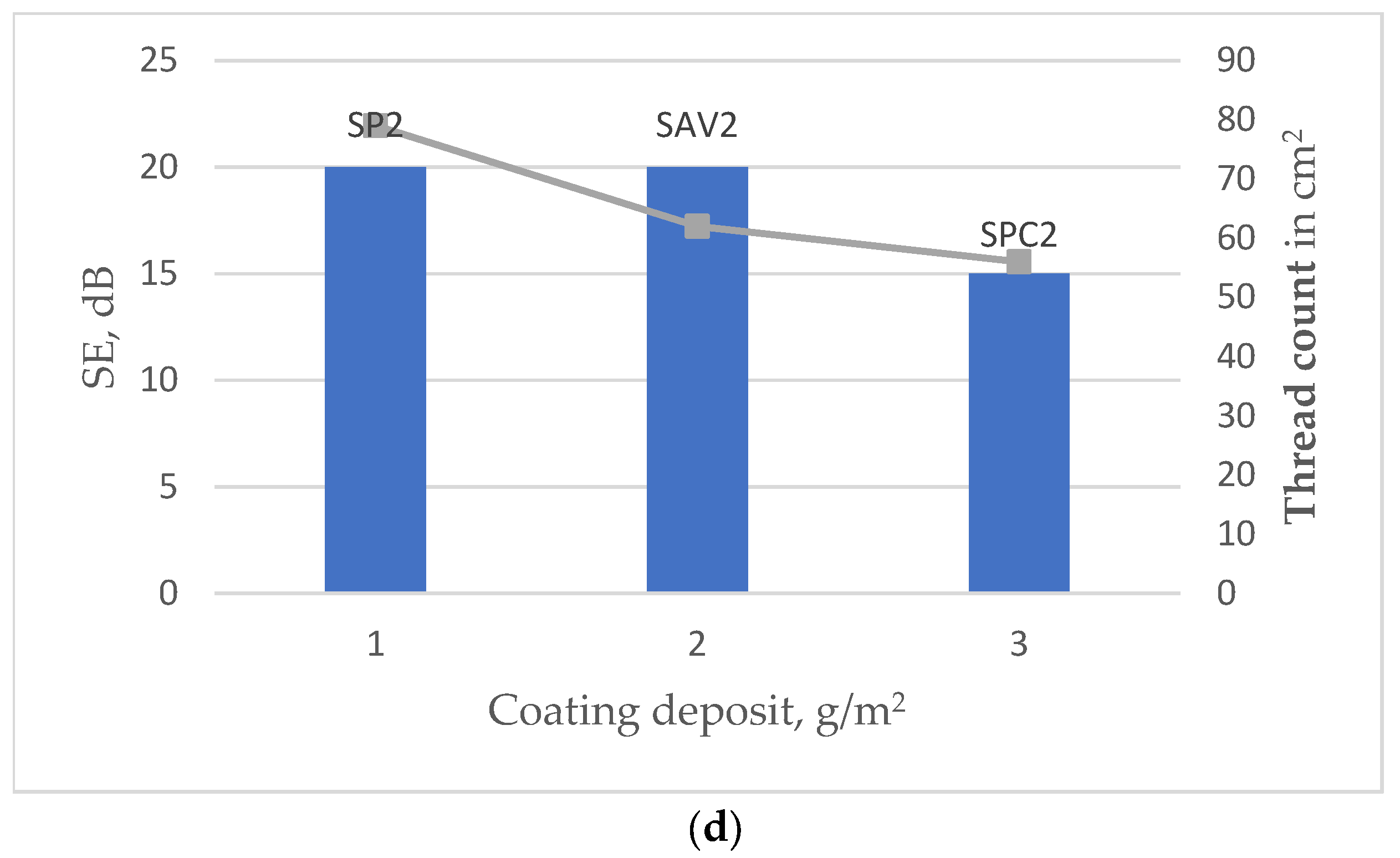

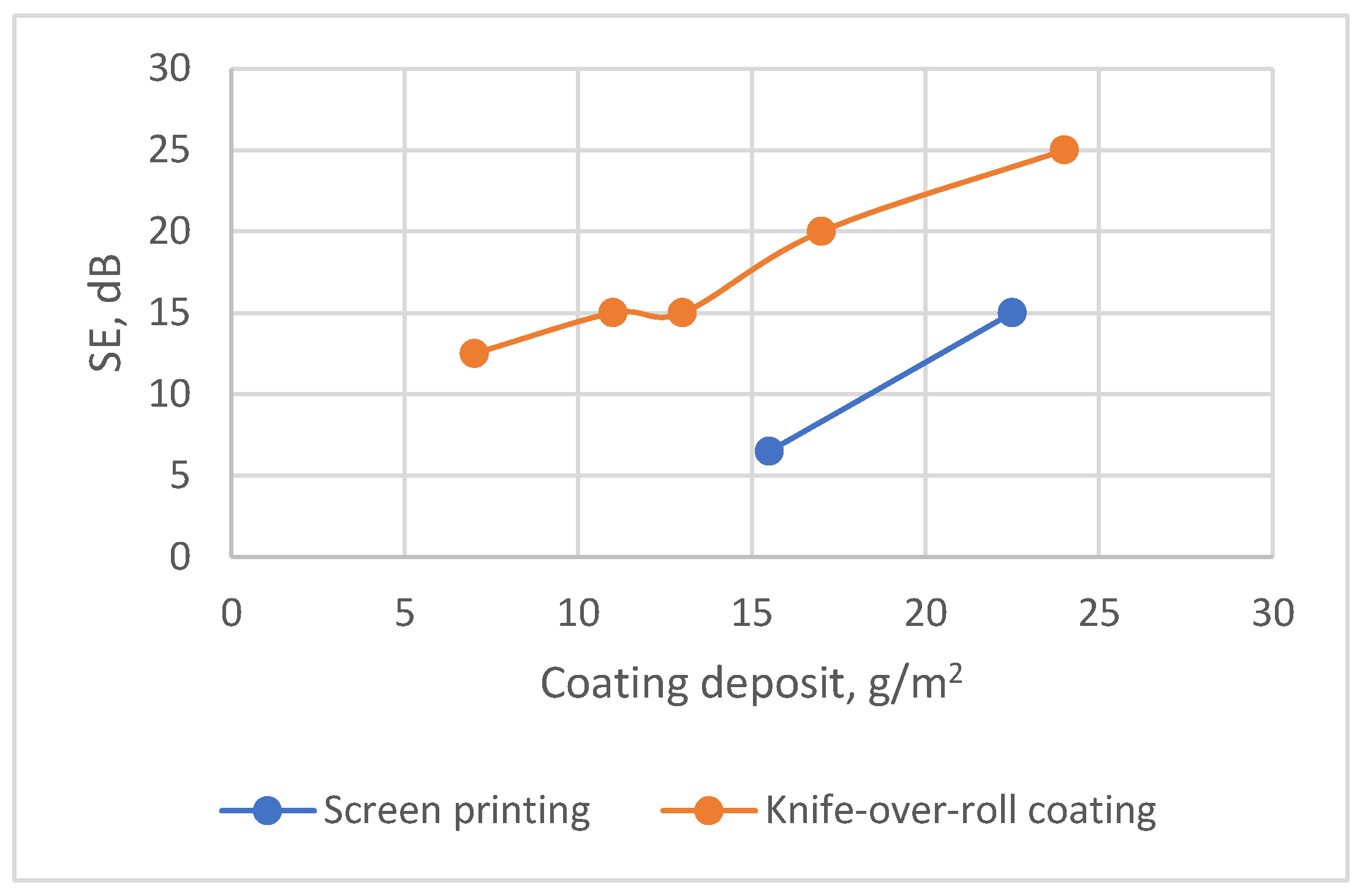

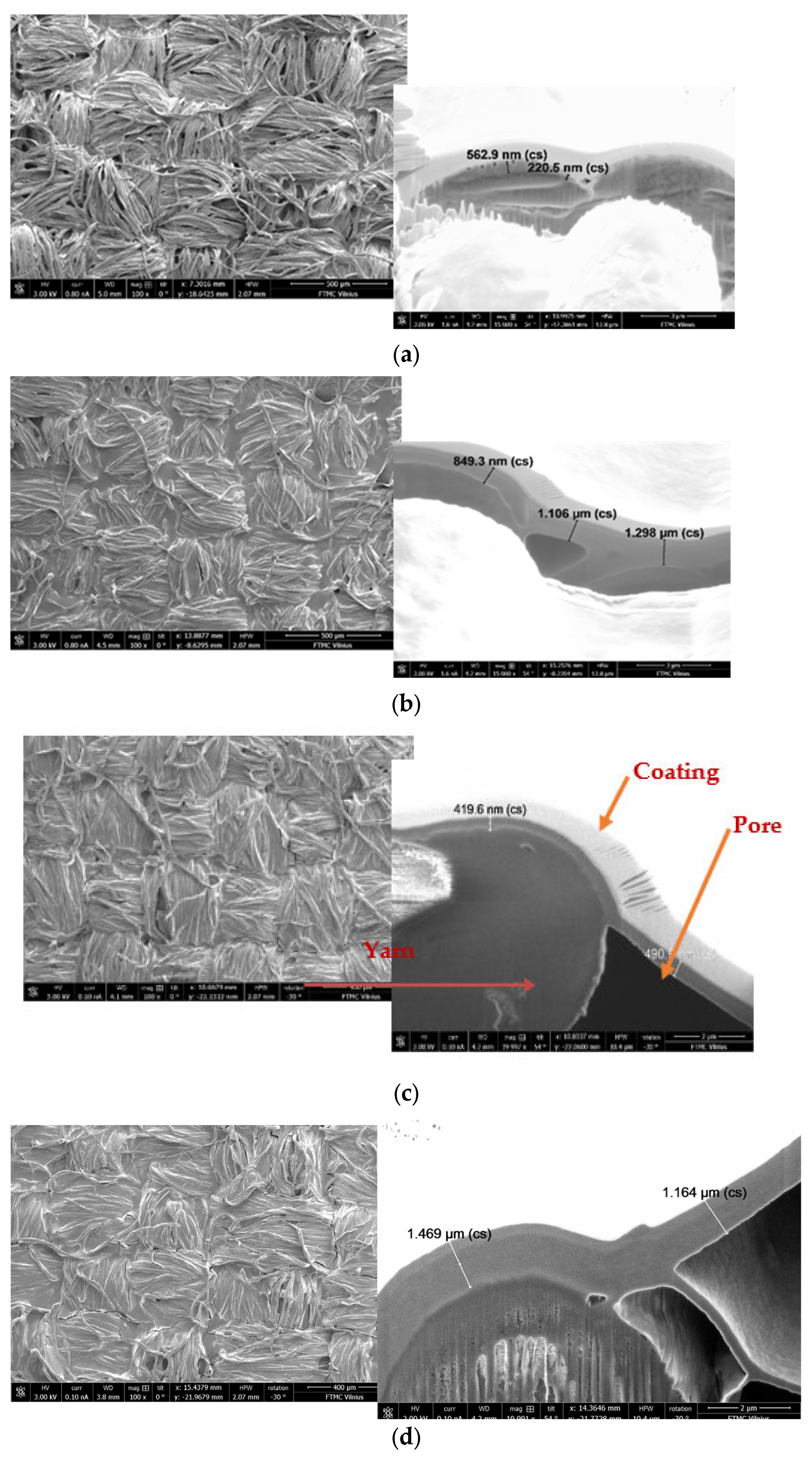
| Substrate (Code, Weave, and Fiber Composition) | Mass per Unit Area, g/m2 | Thread Count in cm2 | Thickness, mm | Air Permeability, mm/s | Moisture Management | Aqueous Solution Repellency Grade | |
|---|---|---|---|---|---|---|---|
| Wetting Time, Grade | Absorption Rate, Grade | ||||||
| PC (plain) 58% Cotton 42% Polyamide | 227 | 56 | 0.60 | 25.5 | 3–4 | 3–4 | 0 |
| NV (plain) 50% Nomex 50% Viscose | 140 | 31 | 0.44 | 1315 | 4 | 3 | 0 |
| C (plain Cordura) 100% Polyamide | 215 | 34 | 0.50 | 70 | 3 | 1 | 2 |
| P (twill) 100% Polyamide | 122 | 79 | 0.35 | 62.3 | 4 | 3–4 | 0 |
| AV (ripstop) 55% Aramid 45% Viscose | 247 | 62 | 0.51 | 52.7 | 3 | 3 | 0 |
| Composition/information on ingredients (component name) | Benzenesulfonic acid, ethenyl-, homopolymer, compound with 2,3-dihydrothienol[3,4-b]-1,4-dioxin homopolymer |
| Concentration | 1–3% w/w |
| Surface resistivity (test print) | 700 Ω/sq |
| Product description (supplied form) | Aqueous dispersion |
| Dynamic viscosity | 3.000 mPa × s (23 °C) |
| Kinematic viscosity | >40 mm2/s (23 °C); |
| >20.5 mm2/s (40 °C); | |
| Weight ratio (PEDOT:PSS) | 1:2.5 |
| Grade | 1 | 2 | 3 | 4 | 5 | |
|---|---|---|---|---|---|---|
| Index | ||||||
| Wetting Time, s | ≥120 No wetting | 20–119 Slow | 5–19 Medium | 3–5 Fast | <3 Very fast | |
| Absorption Rate, %/s | 0–9 Very slow | 10–29 Slow | 30–49 Medium | 50–100 Fast | >100 Very fast | |
| Sample | Coating Method | Coating Deposit, g/m2 | Coating. Thickness, µm | Dominant Shielding Effectiveness (SE), dB | Reflectance (R) |
|---|---|---|---|---|---|
| PC3 | Knife-over-roll coating | 14 | 1.2–1.5 | 15 | 0.7–1 |
| SPC2 | Screen printing | 23 | 0.85–1.2 | 15 | 0.5–0.6 |
Disclaimer/Publisher’s Note: The statements, opinions and data contained in all publications are solely those of the individual author(s) and contributor(s) and not of MDPI and/or the editor(s). MDPI and/or the editor(s) disclaim responsibility for any injury to people or property resulting from any ideas, methods, instructions or products referred to in the content. |
© 2023 by the authors. Licensee MDPI, Basel, Switzerland. This article is an open access article distributed under the terms and conditions of the Creative Commons Attribution (CC BY) license (https://creativecommons.org/licenses/by/4.0/).
Share and Cite
Rubežienė, V.; Varnaitė-Žuravliova, S.; Sankauskaitė, A.; Pupeikė, J.; Ragulis, P.; Abraitienė, A. The Impact of Structural Variations and Coating Techniques on the Microwave Properties of Woven Fabrics Coated with PEDOT:PSS Composition. Polymers 2023, 15, 4224. https://doi.org/10.3390/polym15214224
Rubežienė V, Varnaitė-Žuravliova S, Sankauskaitė A, Pupeikė J, Ragulis P, Abraitienė A. The Impact of Structural Variations and Coating Techniques on the Microwave Properties of Woven Fabrics Coated with PEDOT:PSS Composition. Polymers. 2023; 15(21):4224. https://doi.org/10.3390/polym15214224
Chicago/Turabian StyleRubežienė, Vitalija, Sandra Varnaitė-Žuravliova, Audronė Sankauskaitė, Julija Pupeikė, Paulius Ragulis, and Aušra Abraitienė. 2023. "The Impact of Structural Variations and Coating Techniques on the Microwave Properties of Woven Fabrics Coated with PEDOT:PSS Composition" Polymers 15, no. 21: 4224. https://doi.org/10.3390/polym15214224






